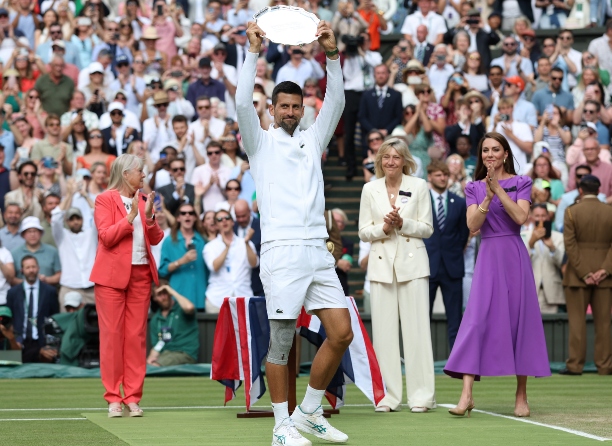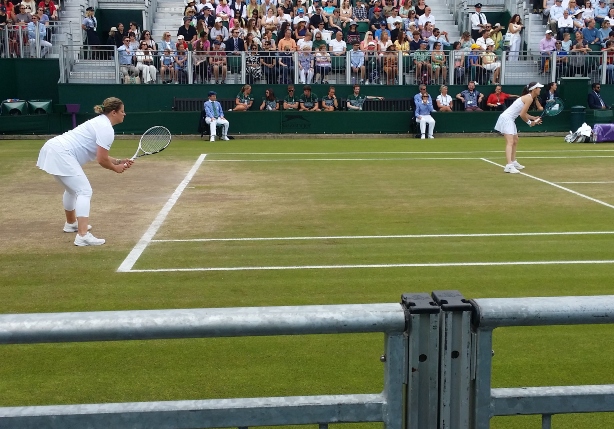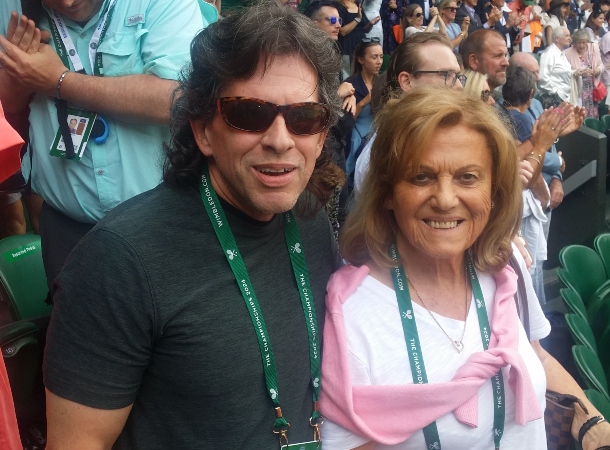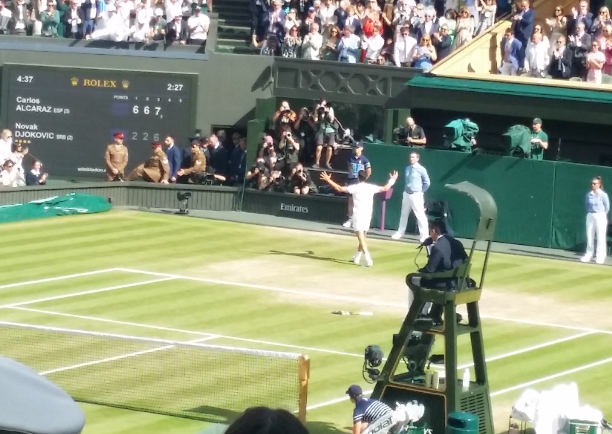By Richard Pagliaro | @TennisNow | Tuesday, July 16, 2024
We saw inspired tennis and a generational shift at Wimbledon. Richard Pagliaro shares his top takeaways from a memorable fortnight.
Photo credit: Rob Newell/CameraSport
Wimbledon—Transformative tennis came to Centre Court.
Seeing Carlos Alcaraz thrash seven-time champion Novak Djokovic 6-2, 6-2, 7-6, was a generational shift as striking as seeing Wimbledon on HD TV for the first time.
Everything looks sharper, vivid possibilities bloom and we’ll never see the sport the same way.
The 21-year-old Alcaraz made history joining Bjorn Borg and Boris Becker as the third man in the Open Era 21 or younger to win multiple Wimbledon titles.
On the ladies side, Barbora Krejcikova channeled the spirit of her beloved mentor, 1998 Wimbledon winner Jana Novotona, fending off feel-good story Jasmine Paolini 6-2, 2-6, 6-4 to become the eighth different woman in the past eight years to win Wimbledon.
It is Krejcikova’s second Grand Slam singles title, coming three years after she defeated Anastasia Pavlyuchenkova 6-1, 2-6, 6-4 in the Roland Garros final. This Wimbledon run should ensure former doubles world No. 1 Krejcikova’s status as a future first-ballot Hall of Fame champion given her entire body of work in singles and doubles.
The tournament also solidified status in a different way: Paolini was the People’s Champ of this Wimbledon fortnight, and won a legion of fans for her grit and a smile that seemed to spread from Centre Court all the way down to the Southfields Station on Church Road.
Here are our Top 10 Takeaways from our time at SW19.
King Carlos: Creative Lightning
The difference between prior supreme shotmakers and the Amazing Alcaraz is, to borrow the Mark Twain phrase, the difference between a lightning bug and lightning.
Alcaraz amps acceleration and angle to such audacious levels, he’d take Quidditch to new heights if you gave him a stick and a shot.
Centre Court media seating is excellent: behind the corner of the baseline opposite the Royal Box.
From that vantage point, the consequences of court positioning are clear.
In attack mode, Alcaraz can straddle the baseline and unleash rocket 100 mph forehands. When pushed into defense, Alcaraz can corner through those green slippery patches on the perimeter and quickly recover.
In fact, after Alcaraz defeated Queen’s Club champion Tommy Paul in the quarterfinal on No. 1 Court, the 12th-seeded Paul said Alcaraz’s astounding speed and balance are his best assets on lawn.
“He moves unbelievably well. He's probably the quickest player,” said Paul, also one of the quickest on Tour. “It's very hard to get the ball by him.
“Grass suits him. He moves incredible on the grass. It's not easy to change direction the way that he does. He stays pretty low.”
The combination of Alcaraz’s jolting speed, pyrotechnic power and precision on the run expand his shot-making options and squeeze safe space for the opponent.
Court-side observers, including Djokovic himself, rightly pointed out Alcaraz beat the 37-year-old Serbian superstar to the ball and played at a different pace.
“I was just a half a step behind him in every sense. That's the reality that I have to accept at the moment,” Djokovic said.
Look, you could be Usain Bolt at his very best and you are not covering the deep 100 mile-an-hour forehand rocket he can launch down the line and the droppers he can dab and drizzle on the front court like splotches of yellow paint on a green canvas.
That’s why I truly believe Alcaraz will win at least 5 Wimbledon titles barring injury.
Two other Alcaraz anecdotes from his practice the day before the final:
1. In practice Alcaraz tried to hit that smash drop shot he bungled against Medvedev in the semifinals. He netted it again.
2. Right after practice, Alcaraz's agent handed him several tennis balls to sign. Then, as Alcaraz walked back to the club by himself, he handed out the signed balls to kids who stopped him to ask for an autograph. Alcaraz also looked very relaxed after that Saturday practice stopping to take selfies with fans, smiling and generally looking quite comfortable.
Serve Statement
The Alcaraz artistry fools us all at times.
It’s so easy to be mesmerized by Alcaraz’s ability to detonate drives then suddenly shift to decorate finesse—who else can rock the ball 100 miles and hour then sift a soap-bubble speed drop shot on the next shot?---but don’t lose sight of what frames the artistry.
Alcaraz out-served outstanding major servers in defeating Djokovic in the final and Daniil Medvedev in the semifinals.
Though he’s 6-feet tall, which is modest in today’s game, Alcaraz uses his athleticism to explode into the serve and his right arm is as live and as loose as a whip.
Consider in the semifinals and finals, Alcaraz faced two outstanding returners in Daniil Medvedev and Novak Djokovic and faced only six break points total.
In the semifinals and finals, Alcaraz lost serve just four times combined against fellow major champions.
When Jimmy Connors owned and played on the senior tour back in the 1990s, I once asked him the toughest server he ever faced.
“Kevin Curren,” Connors replied without pause. “He hit the toss on the rise, so quickly out of his hand, you couldn’t read the serve.”
While Alcaraz doesn’t hit his toss quite as quickly out of his hand as Kevin Curren or Roscoe Tanner or Nick Kyrgios, it is very, very tough to read the ball out of his hand.
Alcaraz’s serve technique and aversion to patterns are two of his top assets.
Goran Factor
While Novak Djokovic was denied his quest for a record 25th Grand Slam championship, he did make a personal mark.
This was Djokovic’s first Wimbledon final without a coach—-though he had an entire LaCoste clad team, wife Jelena and their adorable kids in a packed box.
Still, it makes you wonder: What if Djokovic and Goran Ivanisevic had not split? Or what if they just agreed to work together for another grass season?
Would the Goran factor have helped the seven-time Wimbledon winner’s preparation for the final?
Talking to Hall of Fame historian Steve Flink minutes after the final, he raised the issue of Ivanisevic’s scouting opponent’s serve tendencies and using analytics and data from prior matches as a key to Djokovic’s cause.
Facing the best returner in history, Alcaraz was nearly untouchable on serve—he only faced three break points in the match—and he was complicit in the lone break he allowed when he tightened up serving for the championship at 5-4 triple championship point.
You can’t fault Djokovic, who did try to change up his return position, for Alcaraz’s razor sharp serving day. However, it was surprising to hear him say he was surprised by the Spaniard’s serve explosiveness.
“I've never seen him serve that way, to be honest,” Djokovic said. “136. Maybe I was missing something this tournament, but I've never seen him serve that fast. He must have had a really good serving practice day yesterday.”
That’s a head-scratching comment.
I saw Alcaraz hit 130 mph second-serves as body serves at times in his quarterfinal win over Tommy Paul on No. 1 Court. He repeated that tactic at times throughout the tournament. Going hard and heavy into the right hip on second serves against Daniil Medvedev, Alcaraz faced just three break points in that semifinal win.
Facing two elite returners in his last two matches, Alcaraz faced six break points total and lost serve just four times combined in his semifinal and final victories against fellow major champions.
Though I’ve not looked at 2023 stats for comparison, Alcaraz’s serve seemed heavier to me this year in his title defense than last year.
I’m basing that solely on the sound because the ball itself is basically a blur.
Lastly on the serve, I’m not arguing having Coach Goran in his corner would have changed the outcome in Djokovic's favor, I’m saying I don’t think Alcaraz’s sharper serving would have escaped Ivanisevic.
If you’re Djokovic, as great a champion as you are, you must be aware of that and prepare accordingly.
If you can meet with Triumph and Disaster…
Coaches all over the world show students videos of Novak Djokovic at his best as a teaching tool.
Seeing Djokovic at his worst is the ultimate tennis lesson for me.
The grace and class the Grand Slam king showed after absorbing a thrashing at the hands of Alcaraz, solidifies his status as an iconic champion.
Anyone can be gracious after winning a Slam, but Djokovic is one of the best I’ve ever seen showing dignity in defeat.
Some media and some fans ripped into Djokovic for his response to “Ruuuuune” cheering in his 6-4, 6-4, 6-2 demolition of Holger Rune that saw the Serbian admonish some Centre Court fans for what he viewed as disrespect.
“I know they were cheering for Rune, but that’s an excuse to also boo,” Djokovic said. “I have been on the tour for more than 20 years. I know all the tricks.”
Then, Djokovic bailed out during a BBC interview incurring further sniping. That only adds further fuel for the fire skeptics spark before throwing his US Open default for accidentally hitting the lineswoman in the throat with the ball or his entire imbroglio with Australian officials during the pandemic.
Yet time after time, Djokovic shows real grace and class after absorbing severe shellacking on the Grand Slam stage.
Go back and watch the poise with which Djokovic conducted himself after losing to Alcaraz or how he credited Daniil Medvedev after the Russian shattered the Serbian superstar's dream of completing the calendar Slam in the 2021 US Open final. From Djokovic's extended embrace of his conqueror Alcaraz at net to his on-court speech to the fact he answered every question with depth and candor to his remarks about the Princess of Wales' return to the Royal Box when asked are all examples of a champion's conduct after a painful loss.
And remember, Djokovic did not use his knee surgery as an excuse in the aftermath of the lopsided loss.
We strive to emulate champions when they win, Djokovic is the rare champion who sets the example of how to lose with dignity and respect—for his opponent, for the fans, for the tournament and for the sport.

“If you can you can meet with Triumph and Disaster/And treat those two impostors just the same….”
Those aren’t just words on a wall for Djokovic, who lives it.
Back is Beautiful: Barbora Honors Jana
Barbora Krejcikova’s rise to the Wimbledon ladies’ champion highlighted a beautiful bond.
The 2021 Roland Garros singles and doubles champion Krejcikova converted her third championship point defeating Jasmine Paolini 6-2, 2-6, 6-4 to capture her maiden Wimbledon singles championship.
Channeling the spirit of her mentor and biggest believer 1998 Wimbledon winner Jana Novotna, Krejcikova played with variety and kept her nerve when things got tense in the decisive set.
World No. 32 Krejcikova is the eighth different woman to raise the Rosewater Dish in the last eight years—and the second straight Czech woman to win it following in the footsteps of unseeded friend Marketa Vondrousova last year.
Realizing her greatest dream with eyes wide open—and the spirit of her tennis mentor the late, great Jana Novotna burning brightly in her heart—Krejcikova thrust her arms high, soaked in the moment then blew a kiss toward the sky in honor of 1998 Wimbledon champion Novotna. Jana Novotna died of cancer at the age of 49 on November 19, 2017.
In a powerfully poignant moment, Krejcikova wept seeing her name unveiled on the famed Wimbledon Ladies’ Championship board right near Hall of Famer Novotna, who treated the young Krejcikova with kindness and support when she showed up at the champion's door during her junior days asking for guidance.
"The only thing that was going through my head was that I miss Jana a lot," Krejcikova said of her tears. "It was just very, very emotional. Very emotional moment to see me on a board right next to her.
"I think she would be proud. I think she would be really excited that I'm on a same board as she is because Wimbledon was super special for her."
This victory should not only seal former doubles world No. 1 Krejcikova’s spot in the International Tennis Hall of Fame, it also reinforces the value her Czech compatriots from Martina Navratilova to Hana Mandlikova to Jana Novotna to Petra Kvitova to Lucie Safarova to former partner Katerina Siniakova place on playing singles and doubles.
Krejcikova won because she was the more complete player—owns more shots—and played better when it mattered most. All of those years she’s put in on the singles and doubles court paid off in both of her Grand Slam singles wins. Now, if she can win the US Open or Australian Open she will join Alcaraz winning Grand Slam championships on all three surfaces.
Paolini Power
Jasmine Paolini came up slightly short in her quest to win Wimbledon.
The 5'4" won legions of loyal fans for her dynamic play, mega-watt smile and perpetually-positive attitude.
The 28-year-old Paolini made history as the first Italian woman to reach the Wimbledon final in the Open Era and the first Italian player to contest major finals at two different Grand Slams.
Though Paolini didn't realize her dream, she succeeded sharing the joy.
Paolini reconnected fans with the reason so many of us fell in love with the sport in the first place: it's so much fun and so is she.

It's a bittersweet end for Paolini, who is delighted with her performance powering into back-to-back Slam finals—the first woman since Serena Williams in 2016 to play in the French Open and Wimbledon finals—but disappointed with the final defeat.
Meeting the media afterward, Paolini, who had never won a main-draw grass-court match in her entire career until last month—said she's trying to put it all in perspective after a painful loss.
"I have still to, I think, realize that I did final in Wimbledon. It's an amazing thing," Paolini said. "Of course, now I'm a little bit disappointed. Yeah, as I said, it's been an incredible year. Yeah, I'm enjoying. I hope to continue like that with this level of tennis. I'm going to try to work to keep this focus, this level.
"Yeah, I don't know. I'm just I think enjoying these kind of results that I did. But today it's tough because I'm disappointed a little bit, but it's okay."
We hope new world No. 5 Paolini continues to find the joy in her tennis and share the love with the fans.
After he final practice before stepping on Centre Court, Paolini walked through the crowd of well wishers greeting everyone with a smile.
Even when things aren't going her way, Paolini refuses to have a bad day at work.
The Great Doubles Heist
Tennis matches are moments in time.
If you saw any of the insanely exciting 6-7(7), 7-6(8), 7-6(9) men’s doubles finals victory Harri Heliovaara and Briton Henry Patten scored over Aussies Max Purcell and Jordan Thompson it’s unlikely you’ll forget it for a long, long time.
The unseeded pair fought off a championship point then battled to an unlikely and emotional win.
In the second-set tiebreaker, Thompson had a short forehand volley and could have done anything with it....except what he did which was try to play the short angle drop volley only to see the lefty streak forward and swat a clean forehand pass down the line. That sequence left Purcell dropping his stick in disbelief.
Afterward, Heliovaara said his dad described it as the ultimate Grand Slam heist.
“I think my dad came up to me and said, That was like a bank robbery, which is harsh but fair,” he said. “It seemed like we were always down.
"First set tiebreak, 6-1 down. Clawed back. Lost second set tiebreak. We were 5-2 down, lucky net cord, pretty good return, but pretty lucky at the same time.
“Clawed it back. Mini breaks down in the third set tiebreak. Didn't get near to their serves all match. Yeah, blew open the doors and ran away with the trophy at the end of it basically.”
The title, trophy and the prize money, which will allow the pair to travel, could be career changing.
Demon’s Inferno
Intensity and a determined slide helped Alex de Minaur complete a 6-2, 6-4, 4-6, 6-3 win over Arthur Fils in the fourth round.
The pain inferno consumed Demon’s dreams of a deeper Wimbledon run.
The hip injury de Minaur sustained in his slide to beat Fils forced him to withdraw from Wimbledon before what could have been an intriguing quarterfinal showdown vs. Djokovic.
We tend to focus a lot of time and energy on title runs, rousing rivalries and ranking point pursuits—with good reason—but seeing a despondent de Minaur grimly announce his withdrawal you understand the human toll tennis can take.
Here’s a guy who works his entire life, produces the best season of his career, puts himself precisely where he wants to be: a Centre Court shodown vs. Novak Djokovic at Wimbledon, but unfortunately paid a steep physical and emotional price in the process.
A devastated de Minaur said doctors told him he will likely be sidelined three to six weeks, which would probably rule him out of this month's Paris Olympic Games.
"I’m devastated, but I had to pull out due to a hip injury," de Minaur told the media in a 12:10 p.m. presser. "A little tear of the fiber cartilage that is at the end [and] connects to the adductor. "I felt a loud crack during the last three points of my match against Fils and got a scan yesterday. And it confirmed that this was the injury with high risk of making it worse if I were to step on court."
Here’s hoping for better days ahead for Demon.
Legends Shine On
Through the dank drizzle and cloud clusters legends Martina Hingis and Kim Clijsters shine on.
An annual Wimbledon thrill for me: Watching two of my favorite Hall of Famers Clijsters and Hingis play (read: Dominate) the Ladies’ Invitational Doubles event.
Last year, I saw the pair defeat Cara Black and Caroline Wozniacki in the final on Court 18—the Swiss Miss was the best player on the court that day—played about three hours before Carlos Alcaraz dethroned defending-champion Novak Djokovic in the epic four hour, 42-minute men’s final on Centre Court.
This year, I was fortunate to be second row on Court 12 when the defending champions faced formidable Aussie pair Ash Barty and Casey Dellacqua in the final.
The Aussies broke and went up 3-1—then the Hall of Famers, who each held the world No. 1 ranking in singles and doubles, shifted into gear.
Clijsters and Hingis reeled off 10 games in a row dominating the rest of the match to capture their third consecutive Ladies Invitational Doubles championship.
Clearly, Clijsters doesn’t have the sideline-to-sideline burst or sliding splits she had at her peak—giving birth to three kids and undergoing several surgeries will do that—but she crushes the hip high forehand and served with authority. In fact, Clijsters’ first serve throughout the matches we saw was routinely faster than ladies’ finalist Jasmine Paolini. Clijsters also pulled off a successful tweener in the final though the ball that preceded her would-be winner was called out.
At her best, Hingis played with the fearless feel of a blind pickpocket.
The Hall of Famer’s hand skills are still downright dazzling. Hingis serve-and-volleyed in most serve games, repeatedly challenging Barty’s one-handed slice return, and her touch on the half volley is wondrous.

At one point, Hingis hit an angled drop shot against Barty while Barty was at net—the pair engaged in a brief mini tennis tussle of dueling drop shots—she dropped several topspin lob winners right inside the baseline and showed one of the best volley lobs we saw in the tournament.
A highlight: When the Aussies won a challenge during the Clijsters-Hingis surge, Barty dropped down to one knee pulled the rip cord on a spot-on Lleyton Hewitt lawn mower impression complete with screaming “come onnnnnn!” adding “We won a point!” which prompted laughter from the crowd.
Former world No. 1 Barty looks fit, but shot down suggestions of a comeback with a “no, no, no,” response in her presser.
On championship point, the Aussies, who grew averse to challenging Hingis’ hands at net, played a challenging lob over Clijsters’ backhand side.
Moving backward, Clijsters snapped off the toughest shot in tennis—the leaping high backhand overhead—with ease and power that would have made Patrick Rafter proud to end the match with one of the best non-Alcaraz shots I saw the entire tournament.
Striking Stats
The 20-point opening game that saw Alcaraz break Djokovic was the longest first game in men's final history.
The fastest men's serve was 140 mph, shared by Ben Shelton and Giovanni Mpetshi Perricard.
The fastest women's serve struck was 124 mph by Coco Gauff.
Carlos Alcaraz led the men's tournament in service games broken (41 over 7 matches), while Lorenzo Musetti was second for most service breaks (29 in 6 matches).
On the ladies side, Jasmine Paolini led the tournament with 33 service breaks in 7 matches with Wimbledon champion Barbora Krejcikova second with 30 service breaks in 7 matches.
There were 37 five-setters played at the 2024 Championships and 1,211 hours of tennis played.
Many Thanks!
Many thanks to many people for their help and support during our SW19 stay.
CameraSport photographer Rob Newell shot his ninth Wimbledon for Tennis Now this year. Rob’s dedication, high-energy, good humor, his skill getting the right shot and hard work editing and posting the images for us is all much appreciated.

Thank you to the Wimbledon staff for being so welcoming and professional.
The last three years, as I've walked to Gate 5 to pick up the credential I've been greeted by the same two staffers, who are always very positive and helpful and even walked me to the desk a few years back.
The Championships' attention to detail is quite impressive. For instance, each member of the media was given a gift bag and one of the gifts inside was the official Evian water bottle you saw the players used on court. The bottle has the Wimbledon logo on front and your name embedded on the side.
The tournament also staged a media tennis tournament on the middle Sunday this year, which was well attended.
Many thanks to our fellow tennis journalists including Hall of Famer Steve Flink, Joel Drucker, Richard Evans, Jennifer Paddock, esteemed British writer April Tod, animated Aussie writer Bill who sat in our row for sharing their insights, observations and spending time with us throughout the tournament.
We appreciate all of you for being so generous with your time and your willingness to exchange ideas.

A highlight for me: watching the men’s final while sitting one row behind lefty shotmaker Joel Drucker in the best seat I’ve ever had for a Wimbledon men’s final.
Many thanks to our Air B&B hosts for also making us feel at home—for hanging out, sharing some deep conversation, good protein shakes and providing directions for London and life—and to their cat, the blue-eyed lovely Luna, who kept us company on the late nights and was often dancing on the keyboard when we left the laptop open.
I blame Luna for all the typos and thank her for keeping me company.